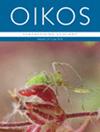Chemodiversity affects preference for Tanacetum vulgare chemotypes in two aphid species
IF 3
2区 环境科学与生态学
Q2 ECOLOGY
引用次数: 0
Abstract
Plants of the same species can strongly differ in their specialized metabolite profiles, which can affect insect presence and abundance in the field. However, how specialized chemistry shapes plant attractiveness to herbivorous insects is not fully understood. Here, we used common tansy Tanacetum vulgare, Asteraceae) – a perennial plant that is highly diverse in terpenoid composition and is known to have variable chemotypes – to test whether 1) plants with different chemotype profiles differ in attractiveness to two specialist aphid species, Macrosiphoniella tanacetaria and Uroleucon tanaceti, in pairwise choice assays; 2) the diversity of the terpenoid blend affects plant attractiveness to aphids; 3) how plant chemical traits relate to plant morphological traits and which traits best explain aphid preference. We found that M. tanacetaria preferred two out of five chemotypes, dominated by α-thujone/β-thujone and β-trans-chrysanthenyl acetate, while avoiding a chemotype dominated by α-pinene/sabinene. Uroleucon tanaceti showed no clear preference towards chemotypes, but when given a choice between chemotypes dominated by α-thujone/β-thujone and by α-pinene/sabinene, they preferred the former. Importantly, plant attractiveness to aphids was marginally negatively correlated with chemodiversity, i.e. the number of terpenoid compounds, in M. tanacetaria, but not in U. tanaceti. Interestingly, the relative concentration and number of terpenoids were generally higher in larger and bushier plants. Hence, we did not observe a tradeoff between plant growth and defence. We conclude that plant chemical composition affects plant attractiveness to aphids and hence may contribute to variation in natural aphid colonization patterns on plants of the same species.化学多样性影响两种蚜虫对丹顶鹤化学型的偏好
同一物种的植物在其特化代谢物特征方面会有很大差异,这会影响昆虫在田间的出现和数量。然而,人们还不完全了解特化化学如何形成植物对食草昆虫的吸引力。在这里,我们利用萜类成分高度多样化且已知具有不同化学型的多年生植物--普通丹参(Tanacetum vulgare,菊科)--来测试:1)在配对选择试验中,具有不同化学型的植物对两种专性蚜虫(Macrosiphoniella tanacetaria 和 Uroleucon tanaceti)的吸引力是否不同;2)萜类化合物混合物的多样性会影响植物对蚜虫的吸引力;3)植物化学特征与植物形态特征的关系,以及哪些特征最能解释蚜虫的偏好。我们发现,M. tanacetaria 偏好五种化学型中的α-�ujone/β-�ujone 和 β-反式-菊甾烷苯乙酸酯为主的两种化学型,而避开一种以 α-蒎烯/桧烯为主的化学型。Uroleucon tanaceti 对化学型没有明显的偏好,但如果让它们在以α-ujone/β-thujone 和以α-蒎烯/abinene 为主的化学型之间进行选择,它们更倾向于前者。重要的是,在 M. tanacetaria 中,植物对蚜虫的吸引力与化学多样性(即萜类化合物的数量)略呈负相关,而在 U. tanaceti 中则不然。有趣的是,萜类化合物的相对浓度和数量通常在较大和较茂盛的植物中较高。因此,我们并没有观察到植物生长和防御之间存在权衡。我们的结论是,植物的化学成分会影响植物对蚜虫的吸引力,因此可能会导致蚜虫在同一物种植物上的自然定殖模式的变化。
本文章由计算机程序翻译,如有差异,请以英文原文为准。
求助全文
约1分钟内获得全文
求助全文
来源期刊

Oikos
环境科学-生态学
CiteScore
6.20
自引率
5.90%
发文量
152
审稿时长
6-12 weeks
期刊介绍:
Oikos publishes original and innovative research on all aspects of ecology, defined as organism-environment interactions at various spatiotemporal scales, so including macroecology and evolutionary ecology. Emphasis is on theoretical and empirical work aimed at generalization and synthesis across taxa, systems and ecological disciplines. Papers can contribute to new developments in ecology by reporting novel theory or critical empirical results, and "synthesis" can include developing new theory, tests of general hypotheses, or bringing together established or emerging areas of ecology. Confirming or extending the established literature, by for example showing results that are novel for a new taxon, or purely applied research, is given low priority.
 求助内容:
求助内容: 应助结果提醒方式:
应助结果提醒方式:


